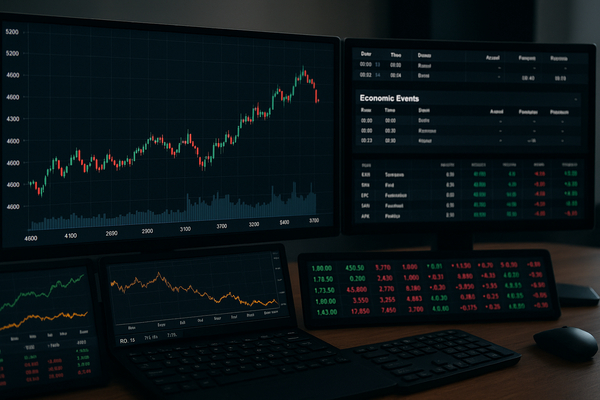
Financial stocks have quietly realigned this week as a confluence of strong ETF flows, upbeat analyst positioning and mixed technical setups push some pockets of the Financials complex higher even as rate, macro and earnings uncertainty persists. The immediate catalyst is the flood of asset-gathering headlines—notably surging Bitcoin ETF inflows—and a string of supportive analyst notes that are sustaining appetite for asset managers and selective banks. For portfolio managers the signal is clear: capital is rotating within the sector toward fee-generating, flow-sensitive franchises while traditional balance-sheet names show a bifurcated technical/fundamental profile that demands selective positioning.
Risk Appetite Returns on ETF-Led Momentum
Market-level momentum is favoring firms with direct exposure to asset flows. BlackRock’s technical score (84.22) and a rising RSI (58.60) underscore a classic momentum trade: heavy inflows into its iShares Bitcoin Trust and other ETFs have translated into sustained price strength. By contrast, index and data franchises such as S&P Global display a marked technical underperformance—SPGI’s RSI sits in the low 20s and its technical score is 20—hinting at an oversold condition rather than a fundamental breakdown. The divergence between technical and fundamental scores across the cohort (for example, BAC’s fundamental score of 71.7 vs. a technical score of 37.08) implies a nascent intra-sector rotation rather than broad-based risk-on activity: managers are reallocating to fee-rich, high-flow names while waiting for clearer macro confirmation to re-engage cyclical balance-sheet exposures.
Macro Headlines Drive Realignment in Rate-Sensitive Assets
Interest-rate expectations remain the primary macro lever for banks and payment networks. Regional and global banks typically re-rate when the yield curve steepens; however, recent headlines have left front-end yields choppy and pushed institutional flow into ETFs as an alternative liquidity play. Bank of America (BAC) and Morgan Stanley (MS) illustrate this nuance. Both show elevated news sentiment (BAC 92, MS 93) and analyst target cushions above current prices, yet technical momentum is tepid—BAC’s RSI near 51 and MS’s 50-day EMAs slightly below price. That combination suggests that while traders will pivot quickly around Fed commentary or CPI prints, longer-term allocators appear to be favoring asset managers and product-distribution platforms until rate clarity returns.
Mixed Fundamentals and Analyst Optimism Paint Diverging Picture
Wall Street’s recommendation mix remains heavily skewed toward buys across large Financials, even where earnings momentum or profitability profiles are mixed. BAC’s analyst profile shows a heavily weighty buy consensus and a median price target (~$56.10) above the current $50.29 close, yet its technical score lags. BlackRock has similarly strong buy-weighted analyst tone and higher price targets while its fundamental score sits at an intermediate 50.66—reflecting that valuation expansion is being driven more by flows and revenue elasticity than by a step-change in core operational metrics. S&P Global stands out as an idiosyncratic case: impeccable analyst sentiment (analyst score 100) and lofty price targets despite soft technicals, signaling that investors may view recent weakness as a potential valuation reset entry point rather than a durable earnings problem.
Earnings Surprise Versus Sector Expectations
Earnings season is an imminent inflection point: several large Financials have earnings scheduled in the next week, raising the odds of intra-sector volatility. Trade-engine and earnings-quality scores (most names clustered in the low-to-mid-50s) suggest that while reported numbers may not dramatically surprise on the top line, guidance and asset-gathering commentary will be the market-moving element. For asset managers, net flows and AUM guidance will matter more than quarter-to-quarter revenue beats. For banks, net interest income trajectories, loan-loss provision language and capital-return frameworks will determine whether recent analyst optimism consolidates into a sustainable re-rating.
News Sentiment and Quant Signals Support Tactical Long Bias
Quant signals and media sentiment point to a tactical tilt toward fee-bearing franchises. BlackRock’s elevated trade-engine score (65.38) and persistent headlines around record Bitcoin ETF inflows have created a feedback loop of flows-to-performance that is drawing institutional attention. Bank of America’s near-maximum news sentiment (92) despite a middling technical score reflects how positive analyst chatter and coverage can undergird price support ahead of earnings. Conversely, S&P Global’s low sentiment score (45) paired with strong analyst targets may present a contrarian long setup for systematic investors looking for a technical breakout following short-term capitulation.
Upcoming Catalysts Could Reshape the Financials Narrative
Over the short run, three catalysts matter: central-bank tone and the upcoming CPI prints that will dictate the yield curve’s slope; next-week earnings across the big Financial names that will reveal whether flows and balance-sheet trends are accelerating; and continued ETF flow updates—particularly around crypto and thematic ETFs—that have demonstrable earnings leverage for asset managers. Institutional investors are likely to run a dual playbook: maintain exposure to flow-capturing managers that show repeatable revenue growth while hedging or underweighting banks until loan growth and NII show consistent improvement post-Fed commentary.
Investor Takeaway: The Financials sector is in a selective uptrend rather than a broad-based rally. Current signals favor a tilt toward asset managers and product-distribution leaders that benefit directly from persistent ETF inflows and fee accretion, while traditional banking franchises will likely need clearer rate direction and positive earnings guidance to sustain a renewed multiple expansion. Key items for portfolio managers to monitor are fund-flow trajectories, earnings guidance on AUM and NII, and the evolution of technical divergences (RSI and technical scores) that can presage a broader rotation. In short, capital is redeploying within Financials—rewarding fee growth and distribution power today and leaving cyclical balance-sheet exposure contingent on macro clarity tomorrow.





